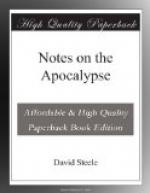17. And I saw an angel standing in the sun; and he cried with a loud voice, saying to all the fowls that fly in the midst of heaven, Come and gather yourselves together unto the supper of the great God;
18. That ye may eat the flesh of kings, and the flesh of captains, and the flesh of mighty men, and the flesh of horses and of them that sit on them, and the flesh of all men, both free and bond, both small and great.
19. And I saw the beast, and the kings of the earth, and their armies, gathered together to make war against him that sat on the horse, and against his army.
20. And the beast was taken, and with him the false prophet that wrought miracles before him, with which he deceived them that had received the mark of the beast, and them that worshipped his image. These both were cast alive into a lake of fire, burning with brimstone.
21. And the remnant were slain with the sword of him that sat upon the horse, which sword proceeded out of his mouth: and all the fowls were filled with their flesh.
Vs. 17-21.—The position of the “angel standing in the sun,” and “crying with a loud voice;” represents, that Messiah’s judgments would be visible to all the world; and the extent of the invitation to the “fowls,” indicates the vast slaughter of his enemies. Babylon being “utterly burned with fire,” (ch. xvii. 16, xviii. 8,) as a suitable punishment of an apostate church; the “flesh of kings, of captains, of mighty men,” etc., as a sacrifice to divine justice, is given as a feast to the fowls of heaven. The allusion here is to the destruction of “Gog and Magog.” (Ezek. xxxix. 17-20.) These enemies of the saints are to appear and be overthrown before the millennium; and although John borrows the names of these enemies, (ch. xx. 8,) they are not the same as those of Ezekiel; the one appearing before, the other after the thousand years. We have often found the enemies of the church called in the Apocalypse by the names of persecutors under the Old Testament;—Babylon, Egypt, etc.—We may consider the “fowls,” the birds of prey, as symbolizing the kings who retaliate upon Babylon; (as in ch. xvii. 16;) or rather, as the Lord’s people reclaiming their own, of which they had been unjustly and long deprived,—“spoiling the Egyptians.” (Exod. xii. 36.)
Some suppose that the confederacy of the “kings of the earth” with the beast, (v. 19,) is a distinct attack from that mentioned in chapter seventeenth; (v. 14;) but perhaps it is safer to consider it as the same, only more distinctly and fully exhibited here. Indeed it seems, from the agency of the “false prophet,” to be the same event as that under the sixth vial, (ch. xvi. 14;) preparing to the battle of Armageddon. The Lord Jesus as “captain of the Lord’s hosts,” and the army of heaven following him, all of them on white horses, appear to be on the one side; and the beast with the kings of the earth, instigated by the false




